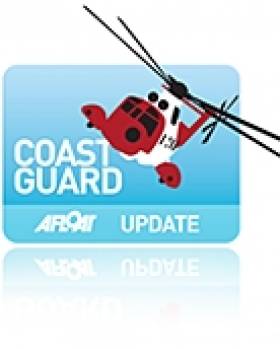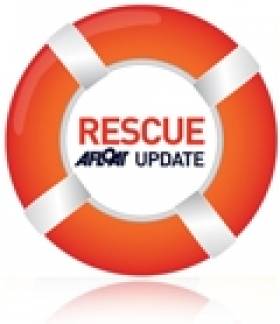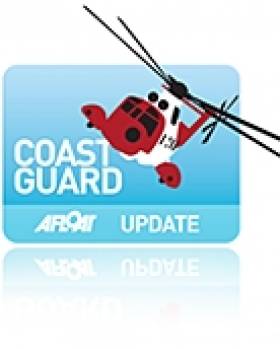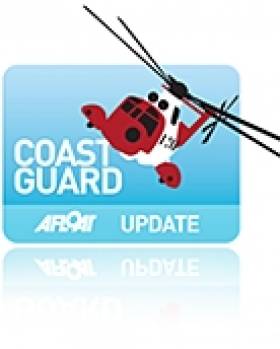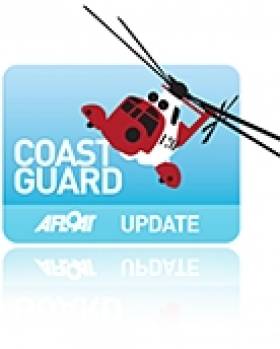Displaying items by tag: Coastguard
Coastguard Takes Delivery of New Chopper
#COASTGUARD - The Irish Coast Guard has taken delivery of its new search and rescue helicopter at its Shannon base, The Irish Times reports.
As previously reported on Afloat.ie, Sikorsky completed production of the new S-92 helicopter for the Irish Coast Guard last December under the rescue service's €500 million deal with CHC Ireland to revamp the aircraft fleet.
The deal will also see the coastguard's remaining four Sikorsky S-61s replaced by second-hand S-62s from Scotland over the coming months.
Training with crews at Shannon is set to begin shortly ahead of the S-92's first public demonstration at the centenary of the Titanic’s departure from Cobh in Cork Harbour.
Meanwhile, it is expected that the Air Corps may be offered an upgraded air ambulance role, after they were ruled out as contenders for search and rescue work amid some controversy.
The Department of Health has reportedly been in exploratory talks with private firms regarding the provision of an inter-hospital emergency air transfer service, as called for by the Roscommon Hospital Action Group.
The Irish Times has more on the story HERE.
Italian Coastguard to Deliver Keynote at Dublin Conference
#COASTGUARD - Representaives of Italy's coastguard will give an account of its handling of the Costa Concordia tragedy at an international conference in Dublin next month, The Irish Times reports.
The Italian coastguard has been invited to deliver the keynote address at Search and Rescue 2012, which is being hosted in Ireland for the first time.
It is expected that this address will include a detailed account of the sinking of the cruise liner Costa Concordia last month.
At least 17 people have died and 12 are still missing after the ship ran aground on the western Italian coast. One Irish couple were among the thousands rescued from the stricken vessel.
Meanwhile, attendees at the conference - which is being hosted in the year of Ireland's charing of the EU coastguard network - will also witness demonstrations of the Irish Coast Guard's rescue helicopter fleet at Weston Airport in Leixlip.
As previously reported on Afloat.ie, Irish Coast Guard director Chris Reynolds has been charged with preparing the grounds for a permanent secretariat to be run by EU coastguard officers.
Search for Fisherman in Irish Sea Enters Second Day
#RESCUE - The Irish Times reports that the search has resumed for a fisherman who fell overboard from a trawler in the Irish Sea yesterday.
The crewman of the Kilkeel-registered fishing vessel Zenith was reported missing some nine miles (14.5km) off Clogherhead, Co Louth.
Yesterday afternoon the Irish Coast Guard and Clogherhead RNLI began an air and sea search and rescue effort, assisted by coastguard helicopter and other lifeboats and vessels in the area.
The Irish Times has more on the story HERE.
Coastguard 'Overwhelmed' By Response to Glandore Search Appeal
#NEWS UPDATE - The Irish Coast Guard told RTÉ News that it has received an "overwhelming" response from the diving community to its appeal to join the search in West Cork for two missing fishermen.
Skipper Michael Hayes and crewman Saied Ali Eldin are still missing after the fishing vessel Tit Bonhomme ran aground in rough seas near Adam's Rock at the mouth of Glandore Harbour.
Only one of the six-person crew - 43-year-old Abdul Mohammed – is confirmed to have survived. The bodies of Kevin Kershaw (21) and Attia Shaban (26) were recovered last week, while the remains of Wael Mohammed (35) were found by civilian divers near the wreck site last Sunday.
Coastguard manager Declan Geoghegan said that search teams now have the 48 divers required to conduct an exhaustive search of the wreck area and urged further volunteers not to travel for the moment.
The search will concentrate on the waters between Adam's Rock and Long Point, where much of the debris from the trawler has washed up.
RTÉ News reports that more than 200 volunteers are assisting the coastal search by boat and on land, which is being co-ordinated from the village of Union Hall.
Report into Death of Crab Fisherman Prompts Call for Review of Stability Standards
#MCIB - The Marine Casualty Investigation Board (MCIB) has recommended a ministerial review of stability standards for fishing vessels following its report into the death of a crab fisherman off Co Cork in January last year.
Gerry Hegarty drowned after a wave struck the crab boat Carraig An Iasc, which was fully loaded with crab pots at the time, causing it to capsize and sending its two-man crew into the water.
Hegarty, who was not wearing a personal flotation device (PFD) or other buoyancy aid, got into difficulty while attempting to swim ashore with his crewmate and skipper James Fitzgerald, who subsequently raised the alarm.
Lifeboats from Ballycotton and Crosshaven, as well as Irish Coast Guard helicopter Rescue 117, were tasked to the incident. Divers from Naval Service vessel LE Emer located the sunken crab boat but no body was found.
A coastguard search of the area continued over a number of days without success. Hegarty's body was eventually recovered on 17 February 2011 at Ringabella Strand in Co Cork.
The MCIB found it probable that the Carraig An Iasc encountered wind or wave action or a combination of both that caused the vessel to heel to an angle beyond which it was able to recover from its loaded condition. The vessel's Code of Practice Declaration of Compliance was valid until 15 July 2013.
The board noted that there have been "a number of incidents caused by overloading boats thus effecting stability", and recommended that the Minister for Transport reviews and revises the stability standards in the current Code of Practice to improve these standards.
It was also recommended that a safety notice be issued to all skippers and owners in the fishing fleet reminding them of their legal responsibility to ensure that all their crew wear PFDs or lifejackets while on deck.
The full report is available to download as a PDF from the MCIB website HERE.
- Crosshaven
- Cork
- Safety
- Fishing
- Ballycotton
- Lifejacket
- Lifeboat
- Marine Casualty Investigation Board
- Coastguard
- Irish Coast Guard
- Skipper
- naval service
- helicopter
- MCIB
- Rescue 117
- personal flotation device
- Minister for Transport
- LE Emer
- standards
- drowned
- crab fishing
- Carraig An Iasc
- Gerry Hegarty
- James Fitzgerald
- PFD
- Ringabella Strand
- Code of Practice
- stability
- overloading
Exclusion Zone Set Up Around Wreck of Fishing Vessel 'Tit Bonhomme'
#GLANDORE TRAWLER – In the interest of safety and to facilitate any search and recovery operations in the vicinity of the sunken vessel the F.V. TIT BONHOMME, the Department of Transport, Tourism and Sport has set up an exclusion zone has been created around the vicinity of the vessel.
Divers are expected to resume the search for five missing fishermen from the vessel this morning.
The vessel lies between Adam and Eve Islands in the approaches to Glandore Harbour, County Cork.
Only vessels and persons authorised by the Irish Coast Guard (IRCG) are permitted to enter this area, which lies within a 200 metre radius, centred on the wreck in approximate position:
51° 32'.4 N, 009° 06'.1 W.
Accordingly, for safety reasons, all other vessels in the vicinity are requested to keep clear of the exclusion zone and give this area a wide berth.
The exclusion zone will continue until further notice.
IRCG may be contacted at Valentia Marine Rescue Sub-Centre, tel: +353 (0)66 9476109.
#RESCUE – Naval divers are searching a sunken Irish registered vessel for three missing people off Glandore harbour Co. Cork this morning. An operation is underway after a distress call was made at 6 am. Six people were on board and five are still missing from the vessel 'Bonhomme' that sank in 11m of water. A distress call was made just before 6am. The trawler is understood to have been making its way home in force 7 to 8 south-easterly winds when the alarm was raised. The Coastguard and a number of lifeboats are involved in the search. One crew man has been taken to hospital.
#COASTGUARD - The Irish Coast Guard is among the services that can be contacted through a new emergency text scheme for the deaf, hard of hearing and speech impaired, The Irish Times reports.
A pilot for the new www.112.ie service was launched by Minister for Communications Pat Rabbitte yesterday. It enables users who are unable to communicate verbally to send text messages to the Emergency Call Answering Service.
The scheme will run till the end of June, operated by BT Ireland, and will in the words of the minister take "a step closer towards parity of access for all to the emergency services".
Users are required to register online before using the service. They can then send texts to 112 specifying the service needed (whether gardaí, fire brigade, ambulance or coastguard), the problem encountered, the county they are in and their exact location.
The programme has been welcomed by the Irish Deaf Society, which says it finally puts deaf people "on an equal par".
The Irish Times has more on the story HERE.
Efforts Continue to Locate Missing Fisherman on the Irish Sea
#MAN OVERBOARD – At 02.29 am, Holyhead coastguard received a call from a fishing vessel to report one of their crew missing, he had been last seen onboard 1.2 miles west of South Stack on the Irish Sea.
A mayday relay was broadcast by Holyhead Coastguard to alert other vessels in the area and RNLI lifeboats were requested to launch from Holyhead, Porthdinllaen, and Trearddur. A rescue helicopter was also scrambled from RAF Valley. Other fishing vessels in the area are also assisting in the search.
The fishing vessel had departed Holyhead at 11.25 pm and the crewman was last seen at 00.45 am, the vessel alerted Holyhead after finding the man missing at 02.29 am.
Holyhead Coastguard has coordinated the fishing vessels, lifeboats and helicopter in a search in Caernarfon Bay covering an area of fifty square miles.
Jim Green, Watch Manager, Holyhead Coastguard said:
Every effort has been made to try and locate this missing crewman.
The weather in the area is North Westerly F4 with a calm sea and slight swell, the water temperature is eight degrees.
The Coastguard say he was not wearing a lifejacket.
Eight Searches at Cliffs of Moher in 2011 for Doolin Coastguard
#COASTGUARD - The Irish Coast Guard's Doolin unit conducted eight searches for missing people at the Cliffs of Moher in 2011, according to The Irish Times.
Doolin officer Mattie Shannon told the paper that six bodies were recovered by the coastguard unit of the cliffs, which are one of the most popular tourist destinations in the country - but have also become a blackspot for suicide attempts.
The Samaritans have put up signs in the area advertising their helpline, while staff at the cliffs' visitor centre have received training for suicide intervention.
A spokesperson for The Samaritans said that the installation of a special phone with a direct line to their anonymous counselling service may also be considered.
The Irish Times has more on the story HERE.



























